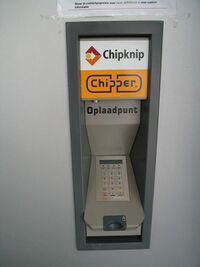Finance:Chipknip
Chipknip was an electronic cash system used in the Netherlands until 1 January 2015. All ATM cards issued by Dutch banks had smart cards that could be loaded with value via Chipknip loading stations next to ATMs. For people who did not have Dutch bank accounts, pre-paid Chipknip cards could be purchased at various locations in the Netherlands. Chipknip was used for payments at parking machines, office canteens, and for other small retail transactions. No network access was required by the payment collection terminal. The system was complementary to the online electronic point-of-sale payment system known in the Netherlands as PIN which transfers money between bank accounts in real-time. The maximum value of Chipknip storage and transactions was quite limited but adequate for small retail transactions.
Chipknip was introduced in 1996, based on technology used in the Belgian Proton electronic cash system. The value stored on the card does not need a PIN to unlock it: the card is entered into the reader at the point of payment, and the cardholder simply confirms the transfer of value.
Chipknip is owned by the Dutch organization Currence, which also owns PIN and iDEAL.
Statistics issued at the beginning of 2007 indicated that Chipknip grew by 12% in 2006 over 2005 and was used for 165 million transactions. The average transaction value was €2.68.[1] Transaction volume has grown from 9m transactions in 1998.[2]
Based on a 14% drop in Chipknip transactions from 2011 (171.7 million) to 2012 (148.2 million), managing organisation Currence announced on 27 March 2013 that Chipknip would no longer be accepted or used as from 1 January 2015.[3]
See also
- FeliCa
- Octopus card
References
- ↑ "Chipknip.nl". http://www.chipknip.nl/.
- ↑ "Archived copy". Archived from the original on 21 October 2007. https://web.archive.org/web/20071021051247/http://www.currence.nl/site/site/website/data/00033/Jaarcijfers%20Chipknip%20-%20aantal%20betaaltransacties%202006.2.pdf. Retrieved 2008-01-06.
- ↑ "Nieuws". http://www.currence.nl/nl-NL/NieuwsArchief/Pages/Cu_20130327_Chipknip_verdwijnt_als_betaalmiddel.aspx.
eo:Monkarto


